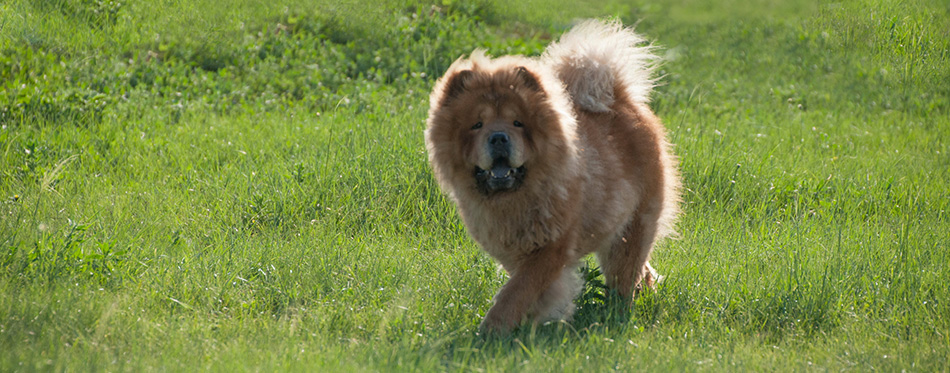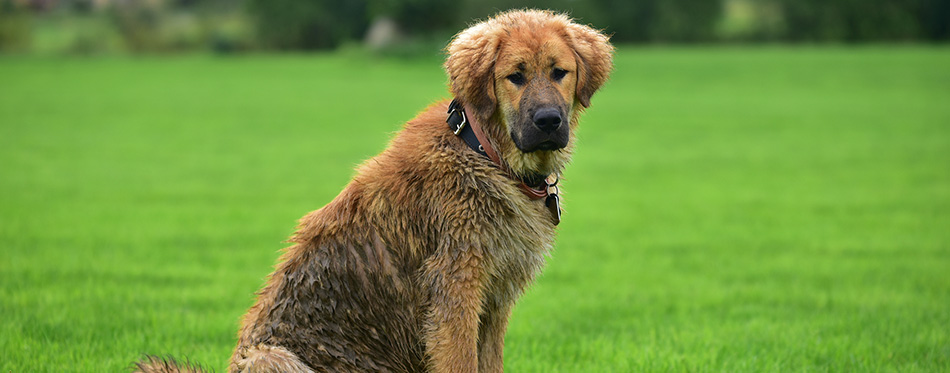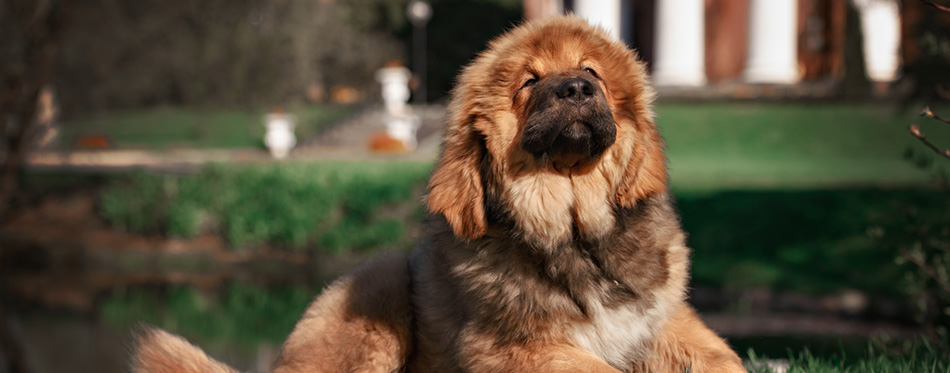The Tibetan Mastiff is an independent thinker, a highly intelligent pup, extremely protective of his human family. The dog displays fierce love for family and has the tendency to be quite good with kids, especially when they are brought up together. However, this large breed of the canine population is not suitable for everyone; what the dog needs is consistent and firm training as well as moderate activity to continue being the quiet watchdog he is supposed to be. If you are in the market for one, continue reading for further information about the Tibetan Mastiff.

History
As the name indicates, the origin of the Tibetan Mastiff is traceable to Tibet; however, very little information exists about the breed but he is believed to have been in existence for centuries.
The breed comes in two different types, we have the Do-Khyi, which followed nomadic shepherds on their extensive travels, lived in the villages, and were used as flock guardians. There is the Tsang-Khyi, which are larger in size, often working with lamaseries serving as guard dogs for the Buddhist monks in Tibet as well as the lamas there.
1847 saw the importation of the first Tibet dog into England; it was a gift from the Viceroy of India Lord Hardinge to Queen Victoria. Following the formation of England’s Kennel Club in 1873, the breed was officially recognized as Tibetan Mastiff, which was recorded in the Stud Book as his name. A couple of the Tibetan mastiffs were imported into England by King Edward in 1874. The trend continued with more importation of the breed until 1931 when they eventually formed the foremost Tibetan Mastiff breed club.
The breed came into the US when the then-president received two Tibetan Mastiffs as a gift; however, the dogs were not heard of after they were moved to a farm. There was still more importation of the breed in 1970, after which the dogs became recognized as the foundation dogs of the US line.
Eventually, they founded the American Tibetan Mastiff Association and the Tibetan Mastiff Club of America in 1974. But the breed’s official recognition a part of the Working Group by the American Kennel Club only became a reality in January 2007.
Quick Facts About the Tibetan Mastiff
- The Tibetan Mastiff is quite big sporting a large head, a heavy bone structure with a dense, long coat of several colors. The head is best described as bear-like, while some liken it to the mane of the lion as it forms a ruff around the dog’s neck. The nose is pitch black, and has short hair covering the head. The dog has a bushy tail curving over his back.
- The coat color can be realized in black, brown, blue, or gold. Some of these dogs are known to sport some markings close to their muzzle, over their eyes, hind and forelimbs, as well as throat. There are still some that come with white markings on their feet and chest, but this is quite rare.
- The dog is one of the largest breeds of the canine population, with the adult male growing as tall as 66cm while the adult female can get up to 60 cm.
- As for bodyweight, the present-day Tibetan Mastiff can weigh from 80 to 150 pounds or even more, giving him that tranquil majestic presence.
- The dog is a typical watchdog and very protective of its human family as well as other house pets. Naturally, it is independent with a mind of its own. Its temperament is best described as territorial and determined and is very suspicious of any stranger around and has the propensity to engage in excessive barking at night, thanks to its origin as a village guard dog.
- Though the dog comes with some desired qualities, it is not suitable for someone who has never owned a dog before. What the Tibetan Mastiff needs is somebody with experience, capable of guiding it with firm, kind, and consistent training. Cruelty and force should not feature in the training of the breed.
- The pup follows its own mind as he is an acclaimed independent thinker, but then, he has the capacity to respond well to routine given a firm hand. The dog is averse to discord; thus, it is a bad idea to stage an argument in the presence of a Tibetan Mastiff. Never discipline a kid in the presence of this giant dog as he is more likely to take it upon himself to stop the scolding or argument by stepping right in. It is equally a bad idea to allow the dog in the vicinity where kids are playing. It can easily mistake the children’s loud pitched voice for violence and won’t hesitate to take charge of the situation by protecting the kids of the family while attacking the neighbor’s children.
- Training for the Tibetan Mastiff should commence at the puppy stage once you bring it home. You can start by taking your canine friend to a puppy kindergarten and also train it in basic obedience class. The best techniques to use with the breed is the positive reinforcement method like play, praise, and rewards; it is a bad idea to use coercion or force.
- Socialization should commence at the early stage; this will prevent the dog from getting excessively suspicious of things that are new as well as different.
- The best place to acquire a Tibetan Mastiff is from breeders that breed their dogs at home. This way, the puppy will be already used to different household sounds, sights, and also people.
- Once the dog has completed his vaccines, you should extend his socialization procedure by taking him out on visits, on outings to places like the local shops or puppy kindergarten. This way, the dog will be able to develop a discerning mind that will help him differentiate a threat from a normal situation.
- As the Tibetan Mastiff gets into maturity, their activity level tends to reduce, but the puppies are quite active, needing enough space to burn their pent up energy in a safe enclosure that is traffic-free. The best home for the dog is a large compound, fenced off with a wall of five to six feet high. The breed is territorial by nature and needs to know their boundaries. An underground electronic fence can never stop the Tibetan Mastiff from getting out if it so desires, and don’t try to walk the dog without a leash. It is not the type that always responds when you call.
- At the puppy stage, the Tibetan Mastiff is a chronic chewer, and thanks to their large size, they can do massive damage to your furniture and walls. So don’t give them a free hand until they get to three years or five years. Always keep the puppies occupied with play, training, and socialization procedure. Once the dog is bored, it becomes destructive.
- It is not a good idea to chain the breed out with no attention, as this is likely to result in aggressive behaviors. The dog can thrive in the great outdoors, and it is an independent pup capable of staying home alone while his human family is away at work. However, it can welcome other house pets as a companion, especially dogs. But it is best to keep your Tibetan Mastiff indoors with you anytime you are around.
- Never allow the dog to stay for long outside as it has the penchant to dig and become aggressive and territorial.
Health
Generally, the Tibetan Mastiff are seen as healthy, but similar to other breeds of the canine population, they are susceptible to specific health problems. They include;
- CHD or Canine Hip Dysplasia: This condition is hereditary, with CHD; the thighbone won’t be able to fit securely into the hip joint, eventually resulting into arthritis or lameness. Any pup that is affected by hip dysplasia shouldn’t be allowed to breed because of the hereditary nature of the diseases; however, the condition can be made worse by environmental factors like rapid growth which is the resultant effect of feeding the dog with high-calorie diet or injuries sustained from fall or jumping.
- Elbow Dysplasia – This is equally hereditary and is common among large-breed pups. It is believed to emanate from unusual growth rates experienced in the three bones, which make up the elbow, resulting in joint laxity.
- Panosteitis – Also referred to as canine growing pains, this condition comes as an inflammation affecting the long bones in young, large-breeds of the canine population resulting in lameness. The pain usually shifts from one leg to the other. The situation can span from one month to half a year; however, it is known to resolve as the dog attains maturity, but you can manage it with pain medication while it lasts.
- OCD or Osteochondrosis Dissecans – This is yet another orthopedic condition resulting from inappropriate growth of the cartilage present in the shoulder joints, though we have seen cases where it affects the elbow too. It gives rise to stiffening in the joint, which can be very painful and is detectable as early as when the pup is between five to seven months. The condition may call for surgery. Since it seems to be hereditary, affected dogs shouldn’t be allowed to breed.
- CIDN or Canine Inherited Demyelinative Neuropathy – This is also hereditary and affects the puppies of the Tibetan Mastiff from six weeks. The disease targets the nervous system, resulting in weakness if the hind limbs, which would likely progressive to total paralysis. There is no established treatment for the disease, but you can avoid it through selective breeding.
- Autoimmune Hypothyroidism – This is an endocrine disorder and quite common among older dogs and middle-aged ones. The condition occurs when there is a shortage of the thyroid hormone — the signs to look out for include; flaky skin, weight gain, and lethargy. You can manage the condition with daily medication, which is a lifelong procedure.
Related Post: Dog Food for Weight Loss

Training
Expose your Tibetan Mastiff to early socialization, which should be a continuous process. You can get a good dog trainer or take your canine friend to puppy kindergarten. Though the dog is naturally stubborn and loves to follow its own mind, it can still learn obedience when you train it properly. One thing is clear with this breed, it is not recommended for novice dog owners; what this pup needs is a firm hand that will teach it obedience.
Exercise
It is very important to expose your Tibetan Mastiff to vigorous exercise on a daily basis. The best way to accomplish this is to give the dog a job to do, which will naturally keep him active. People who wish to keep the breed as a house pet need to have their abode fenced, so the dog has enough space to roam.
You can still take your Tibetan Mastiff for walks, but be sure to put him on a leash as the dog is not the type that will always heed to their owner’s voice. Never allow the dog to go off the leash in public; this is due to the fact that the pup has a natural aversion to strange dogs. The breed is usually very active in the morning time and evenings; if you won’t have time to exercise him during these periods, then the Tibetan Mastiff is the right pet for you. Take a look at our review of the best dog leashes for more info.
Nutrition
Recommendations are that you feed your Tibetan Mastiff twice a day with four to six cups of kibble of high quality (divided into two). You need to avoid bloat or gastric dilatation-volvulus by withholding the dog’s meal for one hour after an energetic exercise session.
Remember that the quantity of food a dog takes is dependent on some factors like age, size, metabolism, activity level, as well as build. Needless to say that a pup that is active will require more food than one which is less active.
The quality of the kibble also goes a long way – the higher the quality, the more it will nourish your pup’s body, and a smaller quantity of the food will be ok for the dog thanks to its high quality. Always check to know when your pooch becomes overweight by giving him the hands-on test and the eye test.
Its waist should be visible when you look down on it. With your hands on the dog’s back, thumbs on the spine, and your fingers coming downwards, the ribs should be felt but not actually seen, even when you don’t apply pressure. If the reverse is the case, then your canine companion needs more exercise and less of food.
For more guides on choosing the right dog food, you may wish to check out our reviews of the best dry dog food, organic dog food, grain free dog food, food for diabetic dogs and dog food for shedding.
Grooming
Shedding for the Tibetan Mastiff may not be seasonal and is quite negligible, but this is dependent on the climate the dog finds himself in. Get rid of loose or dead hair by brushing your pooch up to three times weekly using a wire slicker brush. While brushing, check the dense coated areas like the breeches, mane, and tail for mats or tangles. The breed is not known to develop an offensive odor, but you can expose it to baths once monthly.
Dental hygiene is a necessity with every breed of dog, and for the Tibetan Mastiff, this should be observed twice or three times weekly to get rid of accumulated plaques and tartar as well as the bacteria that may be lurking within. However, daily brushing is the best for those who can accomplish that. The nails should be trimmed as the need arises, especially when they begin to make the clicking sound as the dog moves. With clipped nails, the pup’s feet will be in tip-top condition, and there won’t be any chance of it getting caught in the rug which may result in injury for your canine friend.
The dog’s ears should be subject to weekly checks, and you should be on the lookout for redness, debris as well as inflammation. When dirty, make use of a cleanser and cotton ball to clean the ears. Do a quick work of the outer rim of the ear canal, and remember not to stick the cotton bud too deep.
Start teaching your canine friend to acclimatize to being examined and groomed from the puppy stage. In the same vein, the paws should be handled frequently as the canine population is quite touchy when it comes to their paws. Grooming for the Tibetan Mastiff should be a positive experience associated with rewards, play, and praise; this will, in turn, lay the foundation for trouble-free veterinary examinations, when the dog eventually becomes an adult.
For more help on dog grooming, you may wish to read our guides on the best dog nail grinders, dog dryers, dog clippers, dog paw washers and dog shampoo.

Temperament
The Tibetan Mastiff is known to be quite vicious with a temperament comparable to that of a wild animal. The breed learns very fast; they are strong-willed with a mind of their own and very stubborn. Thus, they are not suitable for formal obedience competition. However, the dog can still learn obedience, given the right training.
By nature, the pup is a territorial animal, and well suited to function as a guard dog and watchdog. Their territorial nature is usually evident when confined to a location, once the dog leaves the confinement, he becomes non-territorial
Once you introduce a Tibetan Mastiffs to an unfamiliar dog, he would like to display dominance. But when the introduction is done properly, the pup is likely to get along with both humans and other animals. Introduction to kids, adults, and other house pets should be carefully done, and this calls for a lot of supervision. The dog is very likely to show aggression with any pup of the same sex.
Source:
- Tibetan Mastiff Dog – PetMD

